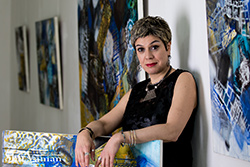
Solo Exhibition "Modern Art Museum"
20 April, 2016,
Yerevan, Armenia |
 |
| |
|
|
 |
 |

|
| |
In 2008 in Pompidou Centre the exhibition of "Traces of the Sacred" was opened under the curator Jean de Loisy, which embraced the western art beginning from romanticism to our days. The organizers of the exhibition declared: " If in the course of this long process the secularization of the society delivered artists from their subordination to the Church, the crisis of religion did not at all mean the disappearance of metaphysical questioning."
The argument of this exhibition is that a significant strain of modern art has its roots in such concerns.
Art continues to witness the reality which is far from ordinariness. Only in art the sacral, the traces of sacred, are preserved and this keeps ties with the eternity. Perhaps in this way Zara Manucharyan's aesthetic search can be described, her desire to find sacral and eternity in the range of art. Her latest series of paintings is dedicated to the sacral areas of Armenia. What distinguishes an artist seeking for spiritual values - he wanders away from the reality, melts into essence then returns to the reality which he sees already changed. His vision is different, it becomes symbolic, he is able to see the mystery of objects and the presence of the sacred.
I think Zara Manucharyan's present series is symbolic from this point of view. Not only the conception is symbolic, not only details of composition but also the technique or the stroke. The first layer of the canvas contains expressive color fields, made of acrylic upon which are the printings in the silkscreen technique,
mainly church plans, churches and Armenian khachkars (cross-stones) lit with subtle and gentle colors. The color in Zara's paintings makes the form more precise and clear-cut. Two realities seem to be present - abstract and spatial.
The artist declares: "The white canvas is not at all a flat surface but a multi-dimensional space where everything becomes possible: even things which are incomprehensible for a three-dimensional world. " These multi-dimensional spaces absorbed light, all the world flows through their transparency, dissolves inside the hidden like in the meditation and the geometric structure of the plans open up as a sacral space. Sacral is first of all the mode of vision, its standpoint. To see the painting there must be the invisible presence of the ideal which gives it the form.
What I see reveals my hopes and desires, the glance stops to enjoy its rapture.
Our vision is inside the picture. But the sacral is invisible as it is not our vision but what glances at us and seeing is grace. Sacral appears, is granted, presents itself and we can remain but its witnesses.
Zara Manucharyan's art is a such like
illustration. The main element in Zara's pictures is the plan.
It is both a geometric ornament and a frame or a pass for the sacral. The plan is a frame as it demarcates the sacral space from the prosaic profane space, makes the church an icon.
The visible shape becomes a frame for the invisible and the frame is the rescue ark. 40 times Gregory Narekatsy's fragments of prayer (31) from his " Book of Lamentations " are depicted in the series. Passing through the pictures we repeat the prayer. So it becomes a kind of a ritual, which sanctifies the painting's surface combining all the hieroglyphs. From the point of view of concept this series can be described as Hierotopy.
What is hierotopy? According to the author of the term Alexey Lidov, it is a kind of art creation, the essence of which is " the creation of the image of a sacred space. This image combines architectural forms and sacred images, ritual objects and ritual gestures, drama of light and distribution of fragrance, the ringing word and the memories of remarkable events of miracles."
In hierotopy the primacy is given not to the object but to the space which is organized in the technique of multimedia
installation and this brings it closer to the experience of modern art. In the church the architecture, relics, light, lay brothers, believers, the service taking place in the church are wholly installation. In Zara's pictures the images of churches, their plans, ornaments, Narekatsy's prayers create a sacred hierotopy based on the personal experience, they are inlaid on the whole series, on every canvas. Zara created this series as a ritual, as a performance.
She was not the witness of the sacred, she was the participant of it. And this is both spiritual and conceptual!
Vardan Jaloyan, art critic
Solo Exhibition "Hilton" Hotel
3 October, 2011,
Sofia, Bulgaria
The white canvas is not at all a flat surface but a multi-dimensional space where everything becomes possible: even things which are incomprehensible for three-dimensional world.
The number of dimensions is not significant since it limits the movement of the matter but not the spirit.
“Armenian shapes” is the movement of my spirit beyond time and space, an esoteric movement inspired by Narekatsi’s holly texts and by mysterious shapes of the old abandoned temples.
These symbols and psalms deliver encoded messages which emanate curative and positive energy.
|

